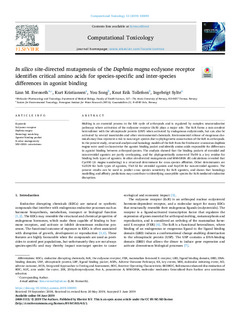| dc.contributor.author | Evenseth, Linn M. | |
| dc.contributor.author | Kristiansen, Kurt | |
| dc.contributor.author | Song, You | |
| dc.contributor.author | Tollefsen, Knut Erik | |
| dc.contributor.author | Sylte, Ingebrigt | |
| dc.date.accessioned | 2019-10-07T13:47:34Z | |
| dc.date.available | 2019-10-07T13:47:34Z | |
| dc.date.issued | 2019 | |
| dc.identifier.citation | Computational Toxicology. 2019, 12, 100091. | nb_NO |
| dc.identifier.issn | 2468-1113 | |
| dc.identifier.uri | http://hdl.handle.net/11250/2620699 | |
| dc.description.abstract | Molting is an essential process in the life cycle of arthropods and is regulated by complex neuroendocrine pathways where activation of the ecdysone receptor (EcR) plays a major role. The EcR forms a non-covalent heterodimer with the ultraspiracle protein (USP) when activated by endogenous ecdysteroids, but can also be activated by several insecticides and other environmental chemicals. Environmental release of exogenous chemicals may thus represent a risk to non-target species due to phylogenetic conservation of the EcR in arthropods. In the present study, structural analysis and homology models of the EcR from the freshwater crustacean Daphnia magna were used to characterise the agonist binding pocket and identify amino acids responsible for differences in agonist binding between arthropod species. The analysis showed that the binding pockets of steroidal and non-steroidal agonists are partly overlapping, and the phylogenetically conserved Thr59 is a key residue for binding both types of agonists. In silico site-directed mutagenesis and MM-GBSA dG calculations revealed that Cys100 (D. magna numbering) is a structural determinant for cross species affinities. Other determinants are Val129 for both types of agonists, Thr132 for steroidal agonists and Asp134 for non-steroidal agonists. The present results can be used to predict cross species sensitivity for EcR agonists, and shows that homology modelling and affinity predictions may contribute to identifying susceptible species for EcR-mediated endocrine disruption. | nb_NO |
| dc.language.iso | eng | nb_NO |
| dc.publisher | Elsevier | nb_NO |
| dc.rights | Attribution-NonCommercial-NoDerivatives 4.0 Internasjonal | * |
| dc.rights.uri | http://creativecommons.org/licenses/by-nc-nd/4.0/deed.no | * |
| dc.title | In silico site-directed mutagenesis of the Daphnia magna ecdysone receptor identifies critical amino acids for species-specific and inter-species differences in agonist binding | nb_NO |
| dc.type | Journal article | nb_NO |
| dc.type | Peer reviewed | nb_NO |
| dc.description.version | publishedVersion | nb_NO |
| dc.rights.holder | © 2019 The Authors | nb_NO |
| dc.source.volume | 12 | nb_NO |
| dc.source.journal | Computational Toxicology | nb_NO |
| dc.identifier.doi | 10.1016/j.comtox.2019.100091 | |
| dc.identifier.cristin | 1712541 | |

